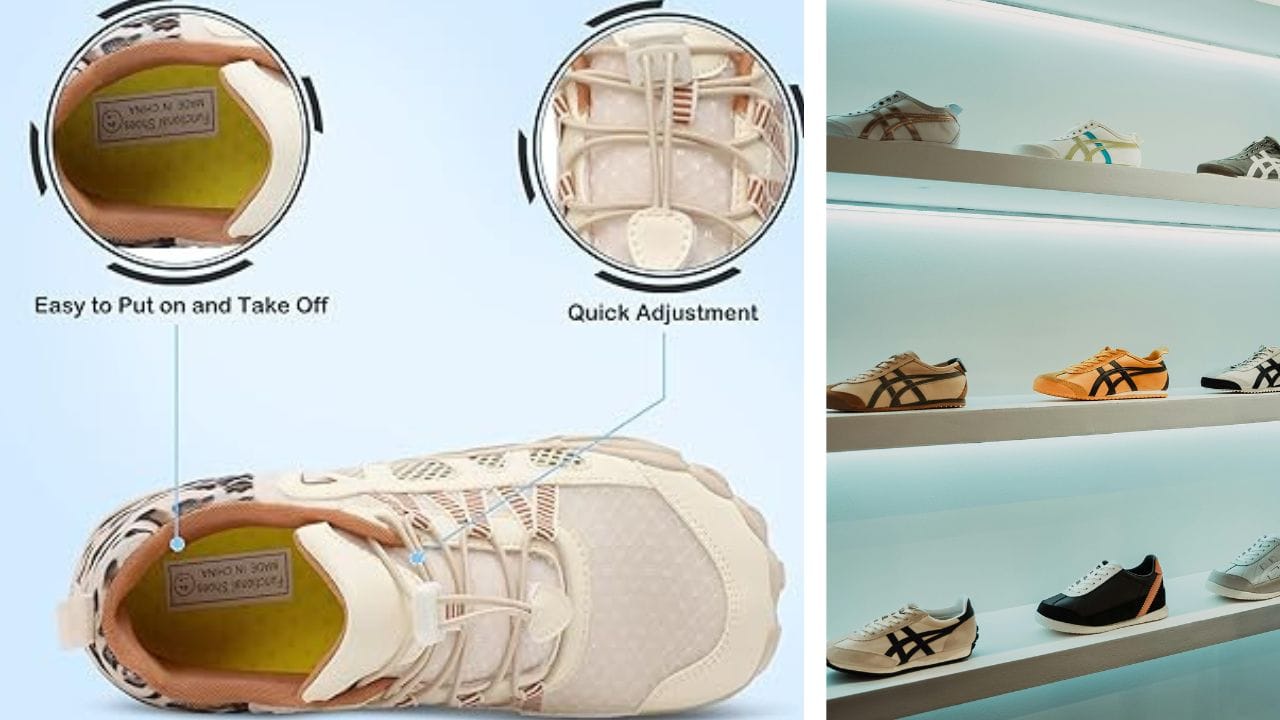How To Choose the Right Barefoot Shoes!
Ultimately, discovering the perfect pair unlocks comfort and natural movement!

Key Takeaways:
- Understanding the benefits and features of barefoot shoes is crucial for making an informed decision.
- Personal preferences and specific needs play a significant role in selecting the right pair.
- Trying on different brands and models can help find the perfect fit and comfort.
Introduction to Barefoot Shoes
Barefoot shoes have taken the footwear market by storm, offering a unique blend of comfort and functionality. These shoes are designed to mimic the natural feel of walking barefoot while providing protection and support. But with so many options available, how do you choose the right pair? This guide will walk you through my process of selecting the perfect barefoot shoes, ensuring you make an informed decision.
The Benefits of Barefoot Shoes
Barefoot shoes offer numerous benefits, including improved foot strength, better posture, and enhanced balance. By allowing your feet to move naturally, these shoes can help reduce the risk of injuries and promote overall foot health. Additionally, they can improve your sensory feedback, making you more aware of your surroundings.
Another significant advantage of barefoot shoes is their lightweight design. Traditional shoes often come with heavy soles and cushioning, which can restrict your movement. Barefoot shoes, on the other hand, are designed to be as light as possible, giving you the freedom to move naturally and comfortably.
Understanding the Anatomy of Barefoot Shoes
To choose the right barefoot shoes, it's essential to understand their anatomy. These shoes typically feature a wide toe box, zero-drop sole, and minimal cushioning. The wide toe box allows your toes to splay naturally, providing better balance and stability. The zero-drop sole ensures that your heel and forefoot are at the same level, promoting a more natural gait.
Minimal cushioning is another key feature of barefoot shoes. While traditional shoes often have thick padding, barefoot shoes have just enough cushioning to protect your feet without compromising their natural movement. This minimalistic design helps strengthen your foot muscles and improve overall foot health.
Identifying Your Needs and Preferences
Before diving into the world of barefoot shoes, it's crucial to identify your specific needs and preferences. Are you looking for shoes for running, hiking, or everyday wear? Different activities require different features, so knowing your primary use will help narrow down your options.
Consider your personal preferences as well. Do you prefer a snug fit or a more relaxed feel? Are you looking for a specific style or color? By identifying your needs and preferences, you can make a more informed decision and find the perfect pair of barefoot shoes.
Trying on Different Brands and Models
One of the best ways to find the right barefoot shoes is to try on different brands and models. Each brand has its unique design and fit, so it's essential to explore various options. Visit a store that specializes in barefoot shoes or order multiple pairs online to try at home.
When trying on barefoot shoes, pay attention to how they feel on your feet. Do they provide enough room for your toes to splay? Is the sole flexible enough to allow natural movement? By trying on different brands and models, you can find the perfect fit and comfort for your feet.
Evaluating the Fit and Comfort
Fit and comfort are crucial factors when choosing barefoot shoes. A good fit ensures that your feet can move naturally without any restrictions. Look for shoes with a wide toe box and a snug fit around the midfoot and heel. This will provide the necessary support while allowing your toes to splay naturally.
Comfort is equally important. Barefoot shoes should feel like an extension of your feet, providing protection without compromising natural movement. Pay attention to any pressure points or discomfort when trying on shoes. If a pair feels uncomfortable, it's best to try a different model or size.
Considering the Material and Durability
The material and durability of barefoot shoes are essential factors to consider. Look for shoes made from high-quality, breathable materials that can withstand regular use. Common materials include mesh, leather, and synthetic fabrics, each offering different levels of breathability and durability.
Durability is particularly important if you plan to use your barefoot shoes for outdoor activities like hiking or running. Check the sole and upper material for signs of wear and tear. A durable pair of barefoot shoes will provide long-lasting comfort and support, making them a worthwhile investment.
Assessing the Flexibility and Sole Thickness
Flexibility and sole thickness are key features of barefoot shoes. A flexible sole allows your feet to move naturally, promoting better balance and foot strength. When trying on barefoot shoes, bend and twist the sole to assess its flexibility. A good pair of barefoot shoes should bend easily without much resistance.
Sole thickness is another important factor. Barefoot shoes typically have thin soles to provide better ground feel and sensory feedback. However, the thickness can vary between models. Choose a sole thickness that offers the right balance between protection and natural movement for your specific needs.
Checking for Zero Drop
Zero drop is a defining feature of barefoot shoes, meaning that the heel and forefoot are at the same level. This promotes a more natural gait and reduces the risk of injuries. When choosing barefoot shoes, ensure that they have a zero-drop sole to reap the full benefits of this design.
Some barefoot shoes may have a slight heel-to-toe drop, which can still offer some benefits. However, for the most authentic barefoot experience, a zero-drop sole is ideal. Check the product specifications or ask the retailer to confirm the heel-to-toe drop before making a purchase.
Evaluating the Toe Box
The toe box is a critical component of barefoot shoes. A wide toe box allows your toes to splay naturally, providing better balance and stability. When trying on barefoot shoes, wiggle your toes to ensure they have enough room to move freely.
A narrow toe box can restrict your toes and lead to discomfort or even injuries. Look for shoes with a spacious toe box that accommodates the natural shape of your feet. This will enhance your overall comfort and foot health.
Considering the Weight
The weight of barefoot shoes can significantly impact your comfort and performance. Lightweight shoes allow for more natural movement and reduce fatigue during long walks or runs. When choosing barefoot shoes, opt for a pair that feels light and comfortable on your feet.
Heavy shoes can restrict your movement and cause discomfort over time. By selecting lightweight barefoot shoes, you can enjoy the benefits of natural movement without any added burden.
Evaluating the Breathability
Breathability is an important factor to consider, especially if you plan to wear your barefoot shoes for extended periods. Shoes made from breathable materials like mesh or perforated leather allow air to circulate, keeping your feet cool and dry.
Poor breathability can lead to sweaty and uncomfortable feet, increasing the risk of blisters and other foot issues. When choosing barefoot shoes, prioritize those with good ventilation to ensure maximum comfort.
Considering the Style and Aesthetics
While functionality is crucial, style and aesthetics also play a role in choosing barefoot shoes. With a wide range of designs and colors available, you can find a pair that suits your personal style. Whether you prefer a minimalist look or a more vibrant design, there's a pair of barefoot shoes for everyone.
Consider how the shoes will fit into your wardrobe and lifestyle. A stylish pair of barefoot shoes can be worn for various occasions, making them a versatile addition to your footwear collection.
Evaluating the Price and Value
Price is an important consideration when choosing barefoot shoes. While it's tempting to go for the cheapest option, it's essential to consider the value and quality of the shoes. Investing in a high-quality pair of barefoot shoes can provide long-lasting comfort and support, making it a worthwhile investment.
Compare prices and read reviews to find a pair that offers the best value for your money. Remember that a higher price doesn't always guarantee better quality, so take the time to evaluate the features and benefits of each pair.
Reading Reviews and Testimonials
Reading reviews and testimonials from other users can provide valuable insights into the performance and comfort of barefoot shoes. Look for reviews from people with similar needs and preferences to get a better idea of how the shoes will work for you.
Pay attention to any recurring issues or praises mentioned in the reviews. This can help you identify potential problems or benefits that you may not have considered. By gathering information from multiple sources, you can make a more informed decision.
Consulting with Experts
If you're new to barefoot shoes or have specific foot issues, consulting with experts can be beneficial. Visit a specialty store or speak with a podiatrist to get personalized recommendations based on your needs and preferences.
Experts can provide valuable insights into the best brands and models for your specific requirements. They can also help you with proper fitting and sizing, ensuring you get the most out of your barefoot shoes.
Testing the Shoes in Different Conditions
Once you've chosen a pair of barefoot shoes, it's essential to test them in different conditions. Wear them for various activities like walking, running, or hiking to see how they perform. Pay attention to any discomfort or issues that arise during these activities.
Testing the shoes in different conditions will help you determine if they're the right fit for your needs. If you experience any problems, consider trying a different model or size to find the perfect pair.
Maintaining Your Barefoot Shoes
Proper maintenance is crucial to extend the lifespan of your barefoot shoes. Regularly clean them according to the manufacturer's instructions and store them in a cool, dry place. Avoid exposing them to extreme temperatures or harsh chemicals, as this can damage the materials.
By taking good care of your barefoot shoes, you can ensure they remain comfortable and functional for a long time. Regular maintenance will also help you get the most value out of your investment.
Summary
Choosing the right barefoot shoes involves understanding their benefits, identifying your needs, and evaluating various features like fit, comfort, material, and durability.
By trying different brands and models, reading reviews, and consulting experts, you can find the perfect pair to suit your lifestyle and preferences. When you're ready, click the button below to see the barefoot shoes we've selected for you to try.

